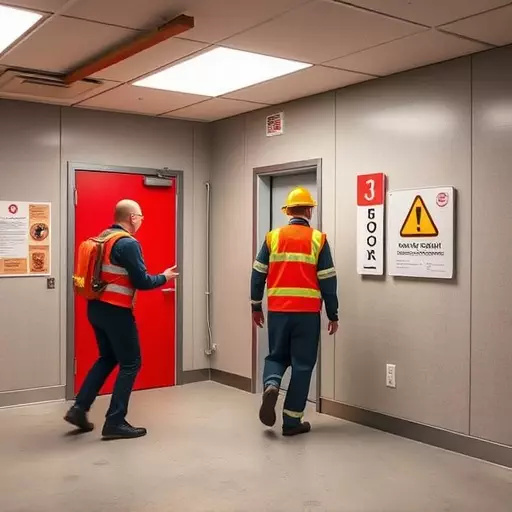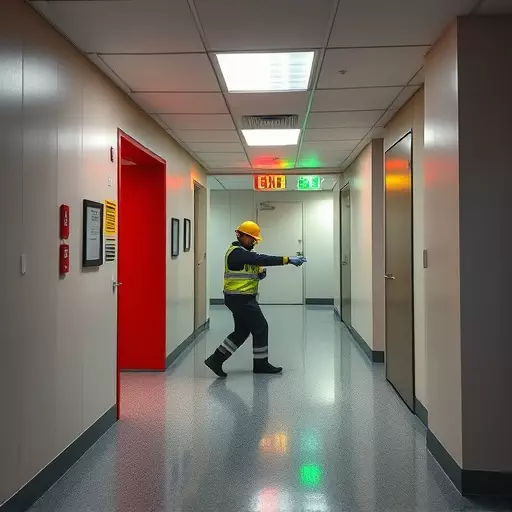Electrical hazards pose significant risks in workplaces, necessitating comprehensive emergency workplace safety training, including regular fire safety and evacuation drill sessions. These exercises teach safe handling of electrical equipment, risk recognition, and effective response strategies, minimizing damage and saving lives. Integrating electrical hazard awareness into fire safety training ensures a proactive approach to prevention and incident management, cultivating a culture of preparedness among employees. Regular updates based on industry best practices, regulatory changes, and employee feedback are crucial for continuous improvement in emergency workplace safety training.
In today’s world, electrical hazards pose a significant risk in various workplaces. This article delves into essential aspects of electrical hazard safety training, an indispensable component of comprehensive emergency workplace safety training. We explore strategies for understanding and mitigating risks, from identifying electrical hazards to conducting effective fire safety training programs and successful workplace evacuation drills. Continuous improvement through regular updates ensures that safety protocols remain robust and relevant.
- Understanding Electrical Hazards in the Workplace
- The Importance of Emergency Workplace Safety Training
- Developing Effective Fire Safety Training Programs
- Conducting Successful Workplace Evacuation Drills
- Continuous Improvement and Regular Updates for Safety Training
Understanding Electrical Hazards in the Workplace

Electrical hazards are prevalent in many workplaces, from offices with outdated wiring to construction sites teeming with power tools. Understanding these risks is paramount for any employee’s safety and forms a core component of comprehensive emergency workplace safety training. Common electrical dangers include live wires, faulty outlets, and overloaded circuits, which can lead to electrocution, fires, or explosions. These hazards often go unnoticed until an accident occurs, making regular fire safety training and workplace evacuation drills crucial.
During these exercises, employees should learn safe handling procedures for electrical equipment, recognition of potential risks, and proper response strategies in case of emergencies. Regular simulations prepare workers to act swiftly during real-life situations, minimizing damage and saving lives. Incorporating electrical hazard awareness into emergency workplace safety training ensures a proactive approach to fire prevention and effective management of critical incidents.
The Importance of Emergency Workplace Safety Training

In today’s fast-paced work environment, where electrical hazards are prevalent in various industries, emergency workplace safety training has become more critical than ever. It is a crucial component of any organization’s commitment to employee well-being and overall operational safety. Regular training sessions that focus on fire safety, electrical risk assessments, and workplace evacuation drills empower employees with the knowledge and skills needed to respond swiftly and effectively during emergencies. This proactive approach not only minimizes potential risks but also fosters a culture of preparedness among the workforce.
Effective emergency workplace safety training goes beyond theoretical knowledge. It involves practical exercises, including simulated scenarios that replicate real-life emergency situations. By participating in these drills, employees can familiarize themselves with evacuation routes, gathering points, and proper usage of fire safety equipment. Such hands-on experiences are invaluable, as they enhance awareness and build confidence in handling critical situations. Moreover, regular training sessions ensure that everyone remains up-to-date with the latest safety protocols, making it a vital aspect of any organization’s risk management strategy.
Developing Effective Fire Safety Training Programs
Developing effective fire safety training programs is a cornerstone of comprehensive emergency workplace safety training. These programs go beyond simple knowledge transfer; they aim to equip employees with practical skills for quick and efficient response during emergencies, particularly fires. Regular workplace evacuation drills play a pivotal role in this process. By simulating real-life scenarios, these drills help individuals understand their roles, familiarize themselves with evacuation routes, and learn how to communicate effectively under pressure.
Fire safety training should be tailored to the specific risks and layouts of the workplace. It must include hands-on exercises, interactive demonstrations, and clear instructions on using fire extinguishers and other emergency equipment. Regular updates and refresher sessions are equally important to keep everyone alert and prepared, ensuring that the workplace remains a safe environment even in the face of sudden emergencies.
Conducting Successful Workplace Evacuation Drills

Regularly conducting workplace evacuation drills is a cornerstone of comprehensive emergency workplace safety training. These exercises mimic real-life scenarios to ensure employees are prepared and know exactly what to do in case of an emergency, such as a fire or power outage. By practicing evacuation routes, meeting points, and communication protocols, teams can significantly reduce panic and improve overall response efficiency.
Effective workplace evacuation drills involve clear coordination and leadership. Managers should assign roles, ensure everyone understands their responsibilities, and simulate various emergency scenarios to challenge preparedness. Regular feedback sessions post-drills are crucial for identifying areas of improvement and reinforcing best practices in fire safety training. This continuous refinement process helps maintain a safe work environment by keeping all employees informed and ready to respond during critical situations.
Continuous Improvement and Regular Updates for Safety Training

In today’s ever-evolving work environment, continuous improvement and regular updates are essential components of emergency workplace safety training. The dynamic nature of technological advancements and changing work practices necessitates that safety protocols remain relevant and effective. Regular reviews and enhancements ensure that employees are equipped with the latest knowledge and skills to handle potential electrical hazards, fire safety scenarios, and workplace evacuation drills efficiently. This proactive approach not only aligns with best practices but also fosters a culture of proactive safety awareness among workers.
Workplace safety training programs should incorporate feedback from previous incidents and employee experiences to tailor educational content. By doing so, organizations can address specific risks unique to their operations. Staying current with industry standards and regulatory changes is vital, ensuring that the emergency workplace safety training meets the highest benchmarks. Regular updates also enable facilitators to introduce new technologies, methodologies, and best practices into fire safety training, enhancing overall preparedness for unforeseen challenges.


